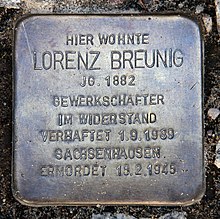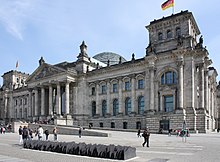Lorenz Breunig

Lorenz Breunig (born August 11, 1882 in Weilbach ; † February 15, 1945 in Sachsenhausen concentration camp ) was persecuted under the National Socialist regime . As a USPD / SPD member of the Reichstag and a trade unionist , he was considered an enemy of the NSDAP .
Life
The resistance fighter's roots are in Weilbach (Bavaria). In 1882 he saw the light of the house no. 73 in what is now Brunnengasse - in Weilbach parlance "Rummelse-Gasse" - as the son of Wendelin Breunig (1854-1924) and his wife Maria, née Rippberger (1860-1900) World.
Almost nothing is known about Lorenz Breunig's childhood and school days, also nothing about the background to the family's move to Aglasterhausen in Baden . After finishing school, Breunig completed an apprenticeship as a lathe operator from 1895 to 1899 and practiced the profession in various regions of Germany, in Austria and also in Switzerland until around 1917 . The activity was interrupted by the drafting into the military during the First World War . In 1905 Breunig married Anna Theresia Schmider, who came from Mannheim . The marriage resulted in six children. The daughter Franziska was born in Weilbach in 1909.
In 1917 Breunig came to Frankfurt am Main as an employee of the Prussian state railway . It was there that he probably made his first contact with the union . In 1919 he moved to Berlin , where he worked as a secretary on the main board of the "German Railway Association". From 1920 to 1924 he was a member of the Reichstag. He was elected via the list of the USPD, in 1922 he switched to the SPD and in 1924 devoted himself exclusively to trade union work in an exposed position.
After the National Socialist " seizure of power ", Breunig was dismissed in May 1933 as secretary on the main board of the German Railway Union. In September 1937, a preliminary investigation into preparation for high treason was initiated against Breunig, who then found employment as a casual worker . Before that, he had worked in a resistance group that acted independently of the large railway resistance group around Hans Jahn . According to a letter from the attorney general at the regional court in Berlin, Breunig met other former SPD members privately, listening to “Moscow stations” and exchanging “inflammatory pamphlets”. Breunig had connections with the International Transport Workers' Federation (ITF) in Brussels; in the spring of 1939 he was temporarily arrested and interrogated in Aachen on his way back from Brussels.
On September 1, 1939, when the Second World War broke out, he was arrested along with 73 other former trade union officials as part of the war special and deported to the Sachsenhausen concentration camp , to which he returned after brief stays in the Plötzensee and Moabit prisons . Breunig was imprisoned in the infirmary for a long time because of a severe asthma illness. Together with over 3,900 other prisoners, including more than 700 from the infirmary, Lorenz Breunig was gassed in the industrial courtyard of the Sachsenhausen concentration camp on February 15, 1945.
Commemoration
Since 1992 one of the 96 memorial plaques for members of the Reichstag murdered by the National Socialists has been commemorating Breunig near the Reichstag in Berlin . In Berlin-Pankow there is another memorial plaque on Miltenberger Weg. In front of the house in Miltenberger Weg, a stumbling block initiated by the railway and transport union has been reminding of Breunig since April 27, 2012 . On June 11, 2005, the local SPD association Weilbach-Weckbach inaugurated a memorial stone for Lorenz Breunig. In addition, the market town named a street after him.
Web links
- Literature by and about Lorenz Breunig in the catalog of the German National Library
- Lorenz Breunig in the database of members of the Reichstag
literature
- Brandenburg Memorials Foundation (ed.): Socialist, trade unionist, resistance fighter. In memory of Lorenz Breunig. Oranienburg 2007.
- Katharina Lübbe and Martin Schumacher: MdR, the members of the Reichstag of the Weimar Republic during the time of National Socialism - political persecution, emigration and expatriation 1933–1945; a biographical documentation. (Publication of the Commission for the History of Parliamentarism and Political Parties) Düsseldorf 1991.
- Siegfried Mielke , Stefan Heinz : Railway trade unionists in the Nazi state. Persecution - Resistance - Emigration (1933–1945) (= trade unionists under National Socialism. Persecution - Resistance - Emigration. Volume 7). Metropol, Berlin 2017, ISBN 978-3-86331-353-1 .
Individual evidence
- ↑ Martin Schumacher (Ed.): MdR The Reichstag members of the Weimar Republic in the time of National Socialism. Political persecution, emigration and expatriation 1933–1945. Droste-Verlag, Düsseldorf 1991, ISBN 3-7700-5162-9 , p. 156.
- ↑ Permanent exhibition in the Sachsenhausen Memorial and Museum, infirmary barracks
| personal data | |
|---|---|
| SURNAME | Breunig, Lorenz |
| BRIEF DESCRIPTION | German politician (SPD, USPD), MdR |
| DATE OF BIRTH | August 11, 1882 |
| PLACE OF BIRTH | Weilbach |
| DATE OF DEATH | February 15, 1945 |
| Place of death | Sachsenhausen concentration camp |

